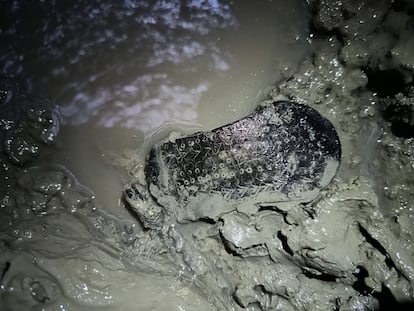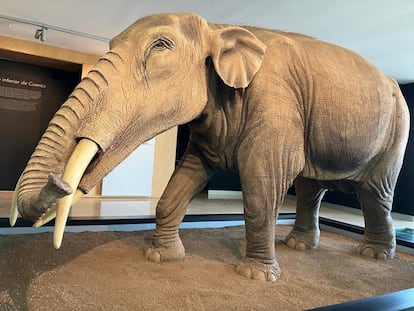The Celtiberian cavalry chiefs gave each other horse brooches to seal pacts
A study reveals that these pre-Romans manufactured the symbolic offerings using the same mold


The main leaders of the Celtiberian, Vaccean and Veton cavalry corps used to wear a horse-shaped fibula about five centimeters long clasped to their clothing. When they died, these breastpins might be buried with them or kept by their descendants as a war souvenir. Now a study — titled The Castellares type horse and rider fibulae. A symbol shared by cavalry chiefs — by the Spanish National Research Council (CSIC) and the Toledo and Complutense universities has analyzed seven of these artifacts.
What the authors found was that all seven were “extraordinarily similar in design, dimension and decoration,” which led them to conclude a specific mold existed that allowed the manufacture of identical models, using “the same technical procedures” and “similar metallic compositions” despite the fact that they were discovered hundreds of kilometers apart, from Spain’s central plateau to the Tagus valley in Portugal. They believe that the brooches were exchanged as personal gifts and that the mold to manufacture them was shared “during the celebration of agreements between chiefs.”
Horse fibulae were made at the beginning of the 3rd century BC and were one of the most significant artifacts of the period. They were associated with the equestrian elites and symbolized “recognition and distinction.” They consisted of a flattened equine body, a hole for the pin that attached them to the fabric of the owner’s clothing and, in approximately 10% of cases, a rider.
The seven brooches analyzed by Juan Pereira, Teresa Chapa Brunet, Ignacio Montero Ruiz, Salvador Rovira Llorens, Cristina Charro Lobato, Alicia Rodero Riaza and Ana Cabrera Díez come from various archaeological sites in Spain: Los Castellares de Herrera de los Navarros in Zaragoza — a Celtiberian settlement destroyed by the Roman general Nobilior —; Arcóbriga in Monreal de Ariza, Zaragoza; Numancia in Garray, Soria where more than 20 examples were found; Las Ruedas in Padilla de Duero, Valladolid; Paredes de Nava in Palencia; Cerro de la Mesa in Alcolea de Tajo, Toledo; and El Tercio I-La Coraja in Torrecilla de la Tiesa, Aldea Centenera, Cáceres. The fibulae have been christened Castellares type fibulae, as the one found at the Castellares site in Zaragoza is the most complete and best preserved of those analyzed.
During their analysis, the experts were surprised to find that “several had the same manufacturing defect, a bubble or crack in the one found in Castellares and Cerro de la Mesa, and a fracture at the insertion point of the rider in the one found in Las Ruedas or Arcóbriga.” Everything pointed, therefore, to the fact that they had been manufactured “from the same mold.”
When analyzing the metal they were fashioned from, it was found that they were all made of leaded bronze, although the proportions of tin and lead varied substantially among them. “This variability suggests that the metal came from different casts and was not the same in all of them,” the study notes. The lead was extracted from mines in the Iberian System, northeastern Spain and Sierra Morena.
The specialists consider that it is most likely that “the fibulae were made using a wax mold” of one or several pieces, as was common in the production of jewelry at the time. “The dimensional coincidences seem to indicate that a single mold is being copied, which reinforces the hypothesis of the existence of a model wooden mold that could have circulated among different workshops. The wax mold was covered with clay, and when it dried, was heated so that the wax melted and disappeared, leaving a hollow to be filled with molten metal. Once the mold had cooled, it was broken and the figure extracted. The surface obtained was treated in the workshop for polishing and then decorated,” according to the study.

Fibulae of the Castellares type appear in the territories of the Celtiberians, Vacceans and Vetons, pre-Roman communities renowned for their bellicose prowess and their struggles against the Carthaginians and Romans between the late 3rd and early 2nd centuries BC. “A characteristic of the European societies of this period was the circulation of prestige goods, converted into diplomatic instruments that reinforced and consolidated the prerogatives of the individuals who made up the leadership of these societies,” notes the study. “Among the different types of interaction, the main ones would have been economic transactions of specialized products, hospitality pacts between allies, military coalitions, and the movement of people, merchandise and livestock.”
Many of these interactions required not only a ritual, but also physical confirmation in the shape of prestigious gifts appreciated by the warrior class, such as weaponry, equine harnesses or horse-themed brooches. As a result of Hannibal’s campaigns in Hispania, diverse pre-Roman communities formed coalitions. “These alliances made by the military leaders had to be accompanied by a certain ceremony,” the study explains. “Among the military leaders, the heads of the cavalry would have enjoyed a prominent role. The generic type of horse fibulae must have circulated among them along with other prestigious goods, such as certain types of weapons and horse harnesses, used to reinforce the ceremonial pacts, which would explain their distribution across a wide area.”
The study concludes that “if we take into account the extensive geographical distribution of the pieces and their different metallic composition, the fashioning of these artifacts must have been carried out in different parts of the Celtiberian, Vaccean and Vetton territories, reaching a remarkable geographical amplitude. If all of them were in fact made from a single mold, we must assume that their production took place over a limited period of time, and that they were the material expression of pacts between chiefs who lived far from each other.” Their production period is between 210 and 133 BC.
The authors of the report also conclude that the fibulae could have been part of their owners’ funerary trousseaus or kept in their homes, where their descendants would treasure them as a souvenir of battles that had pitted them against the first Roman legions to set foot in the region.
Sign up for our weekly newsletter to get more English-language news coverage from EL PAÍS USA Edition
Tu suscripción se está usando en otro dispositivo
¿Quieres añadir otro usuario a tu suscripción?
Si continúas leyendo en este dispositivo, no se podrá leer en el otro.
FlechaTu suscripción se está usando en otro dispositivo y solo puedes acceder a EL PAÍS desde un dispositivo a la vez.
Si quieres compartir tu cuenta, cambia tu suscripción a la modalidad Premium, así podrás añadir otro usuario. Cada uno accederá con su propia cuenta de email, lo que os permitirá personalizar vuestra experiencia en EL PAÍS.
¿Tienes una suscripción de empresa? Accede aquí para contratar más cuentas.
En el caso de no saber quién está usando tu cuenta, te recomendamos cambiar tu contraseña aquí.
Si decides continuar compartiendo tu cuenta, este mensaje se mostrará en tu dispositivo y en el de la otra persona que está usando tu cuenta de forma indefinida, afectando a tu experiencia de lectura. Puedes consultar aquí los términos y condiciones de la suscripción digital.
More information
Archived In
Últimas noticias
Maduro pleads not guilty before the federal court in New York: ‘I am still the president of Venezuela’
A new test can detect Alzheimer’s from a finger prick
UN team enters Sudanese city of El Fasher after paramilitary massacre: ‘It’s like a ghost town’
A recipe for resistance: Indigenous peoples politicize their struggles from the kitchen
Most viewed
- Gilles Lipovetsky: ‘If you want to live better and fall in love, take Prozac, don’t look to philosophy’
- Alain Aspect, Nobel laureate in physics: ‘Einstein was so smart that he would have had to recognize quantum entanglement’
- Alvin Hellerstein, a 92-year-old judge appointed by Bill Clinton, to preside over Maduro’s trial in New York
- Why oil has been at the center of Venezuela-US conflicts for decades
- Maduro’s downfall puts China’s relationship with Venezuela to the test










































